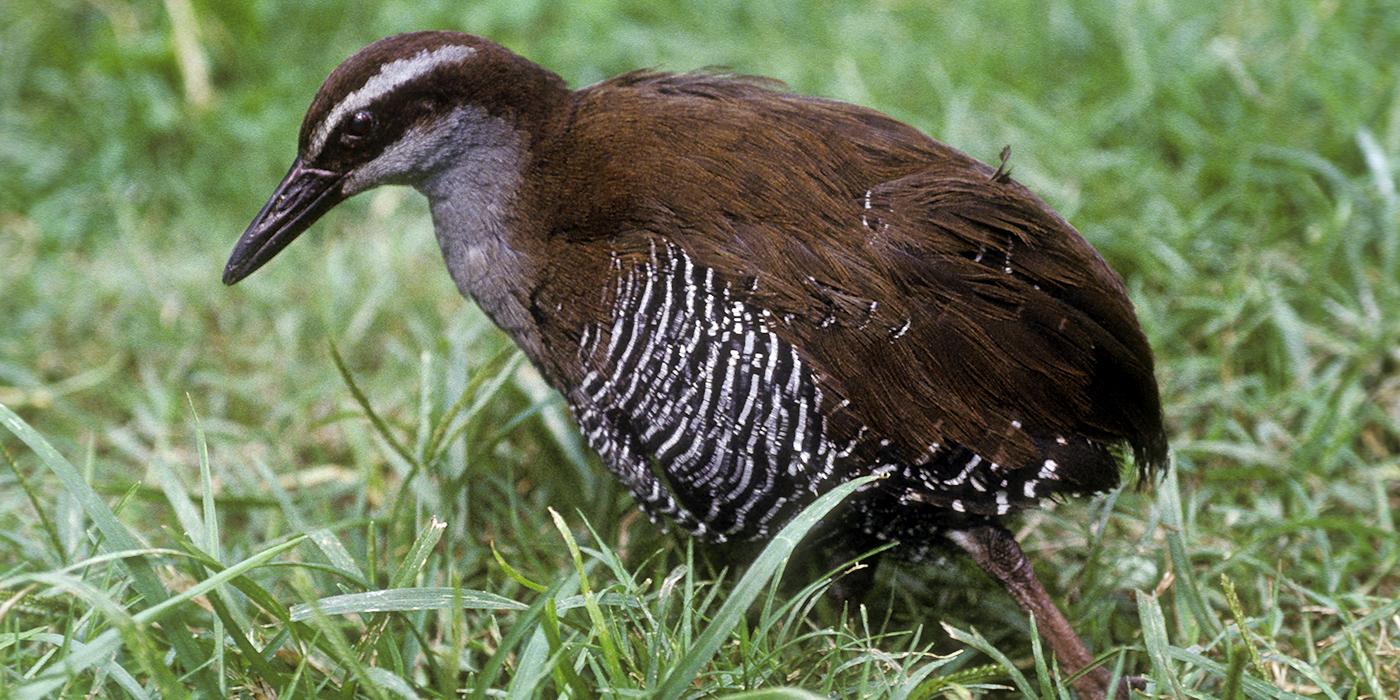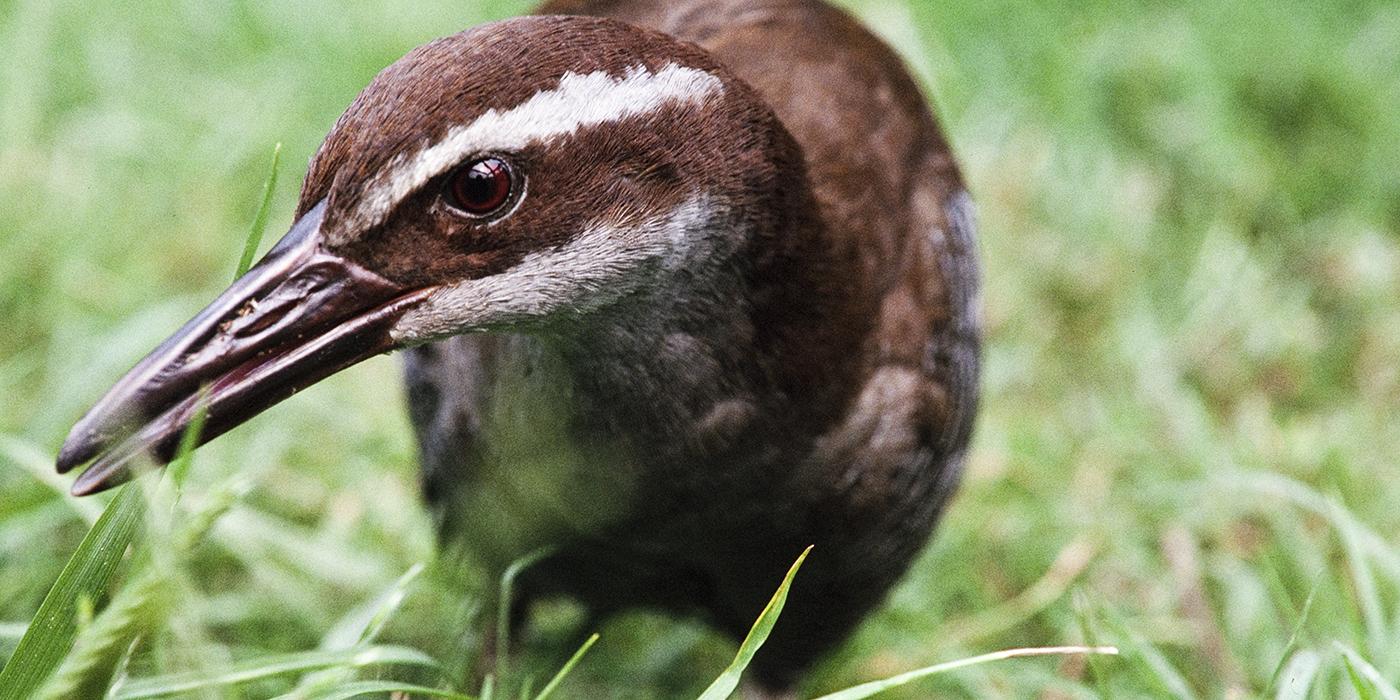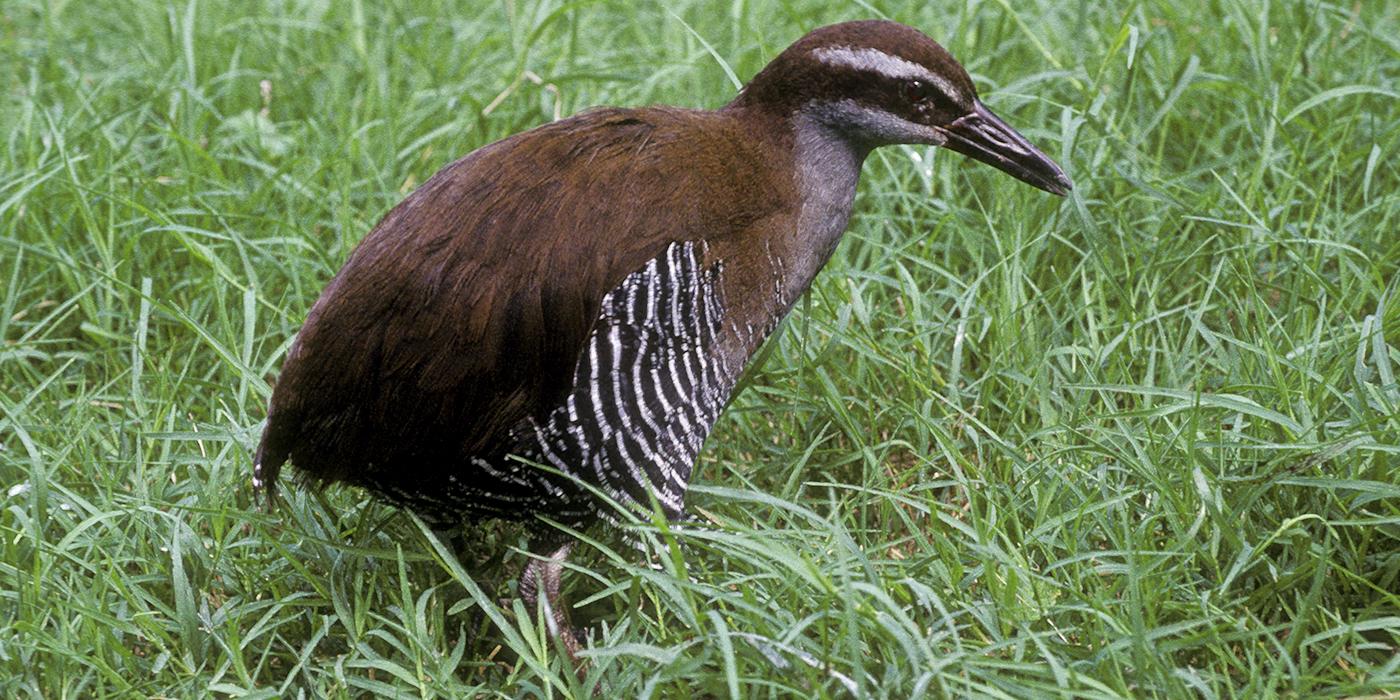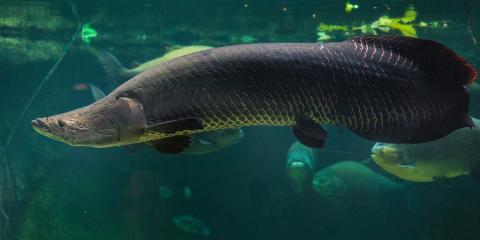Physical Description
Guam rails are small, flightless but fast-running birds with narrow bodies. They have chocolate-brown heads and necks, and a plain gray stripe just above the eye that draws attention to their medium-length gray bills. Their lower necks and upper breasts are also gray, and they have white stripes, called bars, beneath a mantel of light brown shading to buff on the neck. The Guam rail's short wings are dark with brown spots and barred with white. Its lower breast, abdomen, under tail coverts and tail are black with white bars. It has strong, medium-length legs and long toes that help it walk over grasses and soft marsh mud.
Size
Native Habitat
The Guam rail was endemic to Guam and previously found nowhere else in the world. This species was once widely distributed across most habitats on Guam, including scrubby second growth or mixed forest, savanna, scrub, secondary grassland, fern thickets and agricultural areas. Guam rails are one of the few endemic birds of Guam still in existence. They currently survive in the wild only on the islands of Rota and Cocos, where populations were established through breeding programs and releases. Rota is north of Guam and is part of the Commonwealth of the Northern Mariana Islands. Cocos is a small, 33-hectare island about 1 mile off the southern tip of Guam. Cocos is uninhabited, though a day resort does exist on the southern end of the island.
Lifespan
Food/Eating Habits
Reproduction and Development
Guam Rails reach sexual maturity at about five months. They breed throughout the year, with a peak period during the rains from July to November. The male and female construct a shallow ground nest together on dry ground in dense grass, and they share the nesting duties. Females lay one to five eggs in a clutch, and the incubation period lasts 19 to 21 days. The young are precocial and leave the nest to forage with their parents within 24 hours of hatching.
Conservation Efforts
The Guam rail was endemic to Guam, where it was widely distributed until the brown tree snake (Boiga irregularis) was introduced. Guam rails, along with most other indigenous species on Guam, began to decline.
Prior to the 1960s, there were likely about 10,000 Guam rails. Sometime between 1944 and 1952, brown tree snakes arrived on Guam via cargo ships. Before the tree snakes’ arrival, there were no snakes on Guam, so the rail and other native animals had not developed natural defenses against this predator. The tree snakes wiped out the native animal populations. By the 1980s, 10 of the 12-13 native bird species, including the Guam rail, had disappeared.
Because the Guam rail is a ground nester, the brown tree snake was able to feed on its eggs and young. A severe decline in the bird's population took place from 1969 to 1973. In 1981, the population was estimated at 2,000. By 1983, it was reduced to fewer than 100. By 1985, there were only 21 birds remaining in the wild, which were captured to initiate a breeding and recovery program. It survives today in captive-breeding facilities in Guam and in 11 zoos across the United States
Since 1987, efforts have been underway to establish a self-sustaining, experimental population on the nearby snake-free island of Rota, with the first release occurring in 1989. In 1966, a chick was observed on the island, indicating that the birds were capable of successfully breeding in this habitat. Birds have since been released at four sites with mixed success.
As of 2017, it was estimated that there are at least 200 rails in the two restored populations on Cocos Island and Rota. Both juveniles and chicks have been observed on numerous occasions, suggesting that the population continues to thrive on Rota.
In 2011, in an effort to provide safe nesting areas for Guam rails and a place for the public to view them in the wild,16 birds were released on Cocos Island, a small, 33-hectare island about 1 mile off the southern coast of Guam. Before the reintroduction, rats were eradicated from the island, and the forest was further enhanced with native trees. A native lizard survey was conducted to ensure the rails would have enough food to eat, and monitor lizard populations were reduced to minimize their impact on the newly released birds.
The reintroduction proved to be successful—as evidence of breeding has been observed—and will provide a model environment to develop strategies for future reintroductions, as well as expertise in rodent and snake detection, eradication and bio-security measures. The Guam Department of Aquatic and Wildlife Resources (DAWR) continues to monitor the Guam rail populations on Rota and Cocos Island by conducting surveys and tracking birds outfitted with harness transmitters.
Since the 1980s, the Smithsonian's National Zoo and Conservation Biology Institute has taken a leadership role in rescuing Guam rails from the wild. The Smithsonian Conservation Biology Institute initiated a captive breeding program in 1985, under the auspices of the Association of Zoos and Aquariums, with the goal of reintroducing Guam rails and establishing secure populations. SCBI faculty are intimately involved in species management, propagation, research and reintroduction.
SCBI is participating in both the breeding programs and current reintroduction programs on Rota and Cocos Island by producing offspring, completing pre-shipment health screenings for the birds and transporting them to the Guam breeding center as directed by the AZA Species Survival Plan.
Help this Species
- Support organizations like the Smithsonian’s National Zoo and Conservation Biology Institute that research better ways to protect and care for this animal and other endangered species. Consider donating your time, money or goods.
- Share the story of this animal with others. Simply raising awareness about this species can contribute to its overall protection.
- Are you a student? Did you love what you learned about this animal? Make it the topic of your next school project, or start a conservation club at your school. You'll learn even more and share the importance of saving species with classmates and teachers, too.





